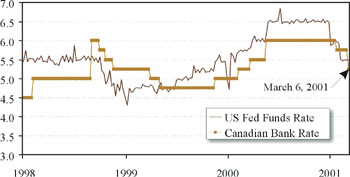International
Global economic growth was exceptional last year, the strongest in over a decade. Real Gross Domestic Product (GDP) grew by 4.1% led by strong expansions in North America, Asia and Europe. Developing countries in Asia and South America, rebounding from the 1997-98 recession, grew by 5.3%. Industrial countries continued to grow after posting several years of back to back gains—3.7% growth was realized in 2000. However, most areas appeared to reach cyclical peaks last year and are expected to show more modest growth in 2001.
The World Bank is predicting that global GDP growth will slow to 3.4% in 2001. Growth in developing countries is expected to dip slightly to 5.0%. Moderating consumer demand in the U.S., particularly for automobiles, will slow growth in developed countries to less than 3.0%.
The recent economic downturn in the U.S., a key export market for this province, is of particular concern. The current slowdown has been triggered by several forces including inflation, higher interest rates and credit tightening, which have eroded confidence. The Country is also being impacted by an emerging energy crisis in California which could further lower consumer and business confidence. The U.S. is addressing the slowdown through both monetary and fiscal policy initiatives. Interest rates have dropped by one percentage point (as of March 13, 2001) and are expected to drop by another 0.5 percentage points by mid-year. Tax cuts have also been proposed. The U.S. economy is expected to grow between 2% and 3% in 2001; however, there is significant risk of a recession occurring in the first half of this year. |
 |
North American interest rates
declining in 2001 |
 |
 |
|
| |
|
|
| Growth in Real GDP (%) |
| |
2000 |
2001f |
| World |
4.1 |
3.4 |
| Canada |
4.7 |
2.0-3.0 |
| United States |
5.0 |
2.0-3.0 |
| Japan |
1.5 |
1.1 |
| European Union |
3.4 |
2.9 |
| Developing Countries |
5.3 |
5.0 |
| Newfoundland* |
5.3 |
2.0 |
* Economics and Statistics Branch, Department
of Finance.
Source: Various, available on request. |
|
National
The Canadian economy performed well in 2000 with real GDP increasing by 4.7% and employment rising by 2.6%. A strong U.S. economy and higher energy prices boosted exports and expanded the trade surplus. Growing demand for computer-related technology spurred machinery and equipment investment while gains in employment and wages, together with tax cuts, helped fuel growth in consumer spending.
Most private sector forecasters are predicting a GDP gain of between 2% and 3% in Canada this year. However, growth is expected to be sluggish in the first half due to impacts of previous increases in interest rates, higher energy prices, a weakening U.S. economy and reduced confidence. Automobile consumption in particular is expected to drop sharply causing a slowdown in manufacturing. However, recent interest rate cuts, remaining pent-up demand (other than automobiles), and momentum from strong growth in recent years should help economic growth bounce back in the second half of the year. Other factors, including a booming oil and gas industry, rising wages, and tax cuts should also fuel growth. |
| |
| |
| |
| |
| Source: US Federal Reserve and Bank of Canada |
|

